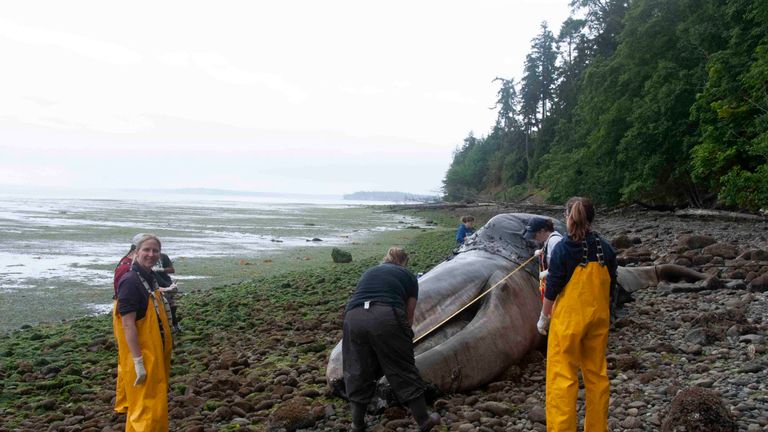Wanted - private beaches for rotting 40-tonne whale carcasses
Authorities say by having a rotting carcass on your land you can "help support the natural processes of the marine environment".
Monday 17 June 2019 16:42, UK
The number of dead gray whales washing up on the US west coast has reached record levels, prompting authorities to ask landowners to help dispose of them.
It comes as figures show around 30 gray whales have stranded in Washington so far in 2019 and another 40 in other west coast areas - the most in about 20 years.
The National Oceanic and Atmospheric Administration Fisheries (NOAA Fisheries) wants waterfront landowners to volunteer their properties for the decomposition of other carcasses - which can weigh up to 40 tonnes.
One couple has already agreed to take part in the scheme - taking on a 40ft carcass that was towed to their private beach.
They already volunteer for a group that responds to reports of stranded marine animals, which was the main reason for signing up.
"How many opportunities do you get to watch something like this happen right out in front of you?" Mario Rivera said.
"We're grateful to Mario for supporting our stranding network and helping us find a location that works for everyone," said Kristin Wilkinson of West Coast Marine Mammal Stranding Network.
NOAA Fisheries says by volunteering sites, landowners can help support the natural processes of the marine environment.
Skeletons remaining after decomposition may also be used for educational purposes, but must be registered with the organisation.
It comes after 261 bottlenose dolphins have been found stranded between Louisiana and the Florida Panhandle between 1 February and 31 May.
The majority were dead, according to NOAA Fisheries.
Experts believe the increased fatality rate could be down to lower levels of salt in the region's seawater as many of the carcasses had "freshwater skin lesions".
Bottlenose dolphins are usually found in waters with high saline levels.




